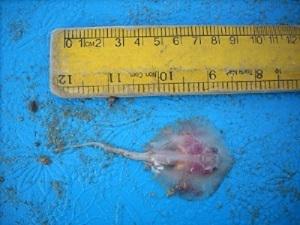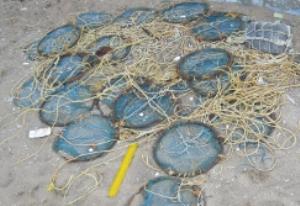Tara Nicole Lawrence
The aim of this project is to document the current species composition, abundance and ecological status of fish that are the primary catch of artisanal fishing communities of the Coromandel Coast. This baseline will be used to address the paucity of data in this sector which has the potential to reform the way fisheries management is approached in India, specifically along the Coromandel Coast.

A juvenile sting ray caught in a gill net off the Coromandel Coast.
In many parts of India—particularly in small or traditional fish landing areas, fisheries data are either unreliable or non-existent. Data on boats, gear and mesh sizes, crew sizes, time spent fishing, etc., are available at very coarse scales and additionally, poor taxonomic identification of fish species, limited abundance and size class information further compounds the issues that confront fisheries managers.

“Kaccha valai” gear specifically targeting snails species from the Family
The problems in this sector are many. Overfishing, IUU (illegal, unreported and unregulated) fishing, over capacitation and management plans with questionable scientific bases are some of the major concerns. The lack of accurate and reliable scientific data significantly contributes to the dearth of information in this sector. Without knowing the most basic information as to what the resource base is, how can fisheries be managed appropriately?
Establishing a baseline which addresses this lack of data with the ability to advise the various facets of fisheries management will be the first of its kind for the Coromandel Coast of India. This baseline can help determine whether changes in the current fisheries support system and existing policies are working and will also enhance the capacity to have adaptive reforms to better suit the needs of conservation and artisanal fisherfolk.
15 months of the project will be dedicated to field surveys comprising 6 cycles of data collection across 30 villages for the purpose of building this baseline. Two researchers will conduct these surveys at the fish landing areas of each village when the fishermen return with their catch for the day. Fishermen will be interviewed using structured questionnaires and the catch will be photographed for identification, measurements and counts. Fish will also be purchased for morphometric, meristic and length weight analysis. The most commonly sighted fish species will be covered within this period for which growth curves will be established. Identification of species caught will be done to the lowest taxon.
Subsequent proposals with more specific conservation objectives will be developed from this baseline. Scientific communications on the ecological status of traditional fisheries will be published in peer reviewed journals. The baseline will also be published online following the completion of this project.